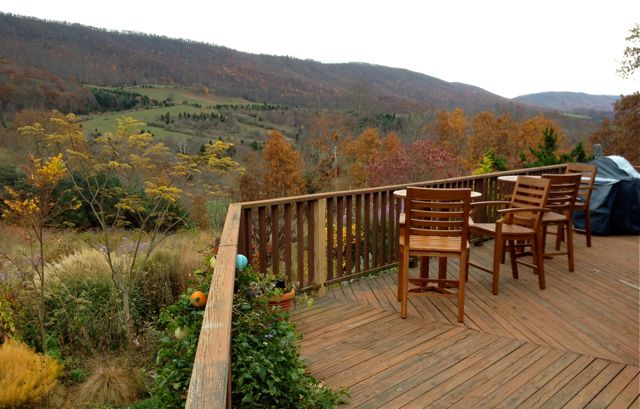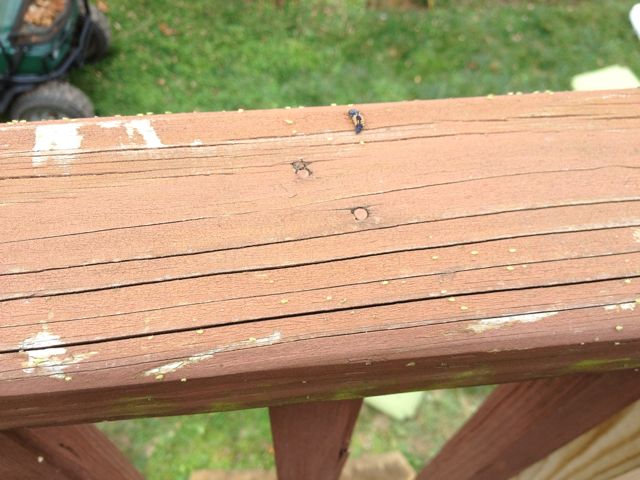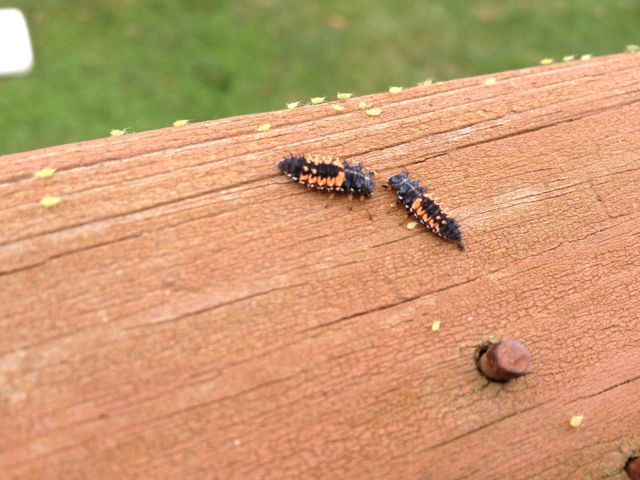Was out enjoying the last of the SW Virginia fall color from our deck, the day before we got our dose of Sandy…the wind was picking up and the barometer and temperature were dropping

Twenty-four hours later, we had an inch of snow and 40 mph winds. No more fall color.
Looked down at the railing and the ENTIRE length of it – 45′ – had aphids streaming back and forth. They were absolutely pouring off a Clematis terniflora vine (the same species that attracted all the blister beetles this summer – what a prize) that had clambered up over the deck. It was like two lanes of traffic, going in each direction, and at a (relatively) high rate of speed. I’ve never seen aphids move so fast. But to where??

I believe it’s time to re-stain the deck.
We also had the interesting phenomenon of congregating swarms of lady beetles (the Asian species – Harmonia axyridis) a couple of weeks ago. The south side of the house and my Jeep were covered. At least there’s an upside to that infestation – I’ve noticed lots of larvae around.
As you know, lady beetle larvae are very effective predators of aphids, and were out in full force amongst the aphids…I counted 30. But they couldn’t make a dent in the thousands of aphids streaming along the rail. Upon closer inspection, they were actually trying to avoid the aphids. They had obviously had their fill and could barely move. I swear they looked nauseous.

“No thanks, we’re full.”
So – any thoughts on why the aphids were so active?
Odds are, like lotsa motivational activity, it has something to do with sex.
You mention that, among other things, the atmospheric pressure is dropping and insects appear all over the place.
Have entomologist studied lowering the pressure as a way to get insects to leave plants? It should be rather easy to toss a plastic over brussels sprouts, hook it up to a shop vac and lower the pressure comparable to an oncoming storm and see if the aphids start leaving the plants.
@janeskid, I did a quick literature search looking for exactly this type of information on aphids. Couldn’t find anything. I did, however, find that as Ray suggested that male aphids DO march off for sex. It would be an interesting study to do!
That was my first thought, too, Jeff, but I checked with Wikipedia and learned they (most of them, anyway) overwinter as eggs. Also noted their asexual seasonal prolific progeny production, that only changes to sexual reproduction at the end of season, hence my guess. I admit, however, that rather than the males marching, I was thinking more along the lines of the females, after a season reproducing non-stop without any male involvement, getting all excited at the prospect of getting some.
Not sure if that makes me a misogynist, or a feminist. I guess I’d have to cop to being a bit of a Mencken-ist.
Not sure the Asian ladybugs care much about aphids. I think their main purpose is to terrorize humans (swarming, biting, stinking, etc.) and it is nice to know that the mountain region can share in the misery we have endured for years.
According to my exit interviews, their purpose was to 1)get away from the incessant swing-state political advertising nonsense, 2)have sex, and 3)find a warm place to overwinter (that would be my heated greenhouse, about 20 yards away).
I am writing an article on beneficial insects for Texas Gardener Magazine. Could I have permission to reuse your photo of lady beetle larva and aphids in the article. You will be fully credited. Thanks!